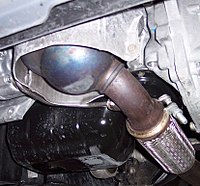
Photo from wikipedia
To predict the behavior of gas-cleaning filters during real-world operation, it is essential to understand their response to ambient conditions. The temporary presence of water droplets in gas-cleaning filtration systems… Click to show full abstract
To predict the behavior of gas-cleaning filters during real-world operation, it is essential to understand their response to ambient conditions. The temporary presence of water droplets in gas-cleaning filtration systems due to fog, spray rain, or condensation, as examples of irregular events, has an impact on the filters’ operating performance, especially when soluble particles are present. In this work, surface filters were loaded with mixtures of water-soluble salt particles and insoluble glass spheres. These were, subsequently, exposed to water mist and dried by a particle-free gas stream. A novel approach to analyze the drainage of solution on filters with soluble filter cakes is presented, which allows the detection of solubles on the clean gas side of the filter. As a result, this work, for the first time, presents a sighting of the penetration of soluble filter cake material through gas-cleaning filters. Furthermore, filter performance, in terms of differential pressure and fractional separation efficiency, was determined and a characteristic differential pressure evolution for hydrophilic filters during exposure to water mist was also identified. The fractional separation efficiency of gas-cleaning filters decreases due to exposure to water mist. The findings are supported by scanning electron microscopy (SEM) images, energy-dispersive X-ray (EDX), and X-ray microtomography (µ-CT analysis) images.
Journal Title: Membranes
Year Published: 2022
Link to full text (if available)
Share on Social Media: Sign Up to like & get
recommendations!